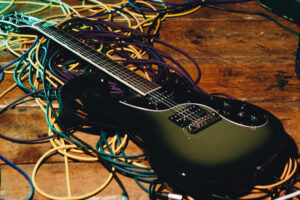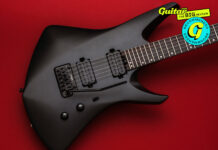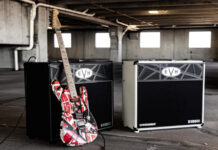
From vintage oddball to alternative classic: the Gretsch CVT’s remarkable journey
Imagine, if you will, a vintage Gretsch electric. Chances are you’re thinking of a Falcon – the brand’s flagship guitars have largely been defined by big hollow bodies, bold accents and a maximalist approach to hardware and electronics.
What you probably didn’t imagine is the Corvette. It’s safe to say that Gretsch’s first solidbody design didn’t take the world by storm when it was launched in 1961, but in the following decades it developed a cult reputation and no shortage of artist associations – from Jimi Hendrix and Rory Gallager, to Patrick Stump and Josh Homme.
The Gretsch CVT on the Guitar.com Cover. Image: Fiona Garden for Guitar.com
This is a golden-era guitar released by a major brand that still somehow has a certain outsider cachet. That’s a vanishingly rare concept in 2025 when everyone is looking for a guitar to stand out from the Strat– and Les Paul-toting crowd, and the most surprising thing is that it’s taken Gretsch so long to give the design its moment in the spotlight, albeit one with a new name: the CVT.
Perhaps it took Gretsch and its corporate stewards at Fender a while to realise the potential power of the Corvette because of how alien it is to the rest of the stable. Even 50 years on, it’s easy to forget what an impact guitars like the Les Paul, Strat and Telecaster had on what had been an exclusively air-filled existence for the electric guitar to that point.
Image: Fiona Garden for Guitar.com
“Solid bodies were like asteroids hitting guitar design!” explains Jason Barnes, the VP of the modern Gretsch guitar brand. “Looking back, it’s easy to get lost in what is and what is not ‘Gretsch’ – but think of the late 1950s and early 1960s. At the time music was so dynamic, sound was evolving so fast. Brands were just trying to make cool guitars that served the music of the day. The Corvette was certainly miles away from a Jet, and miles away from a G6120 – but maybe we have to temper the idea that Gretsch was breaking its own mould!”
The Corvette was, however, no Telecaster. Sales numbers never really took off, and it was discontinued by the mid-1960s. That wasn’t for a lack of variety – the Corvette shifted and changed just as quickly as the rest of the electric guitar world. The body bevels, the bridge and the number of pickups all varied across its short lifetime, and we got a couple of distinct variants, including the very edible-looking Peppermint Twist model and the Princess – the latter a guitar that instantly put the Corvette on a different course to the rest of the guitar world.
“The retro sensibility is there, but it still looks like it’ll kick you in the face!”
A Gretsch for her
“Now for the first time, a guitar that is unmistakably ‘hers.’ When she’s out in front of others, she’ll see the admiration in their eyes.” That was the marketing line that accompanied the launch of the Gretsch Princess in 1962 – a guitar designed to be “feminine in size, light in weight”, according to the catalogue.
The Princess was effectively a Corvette with a fabric pad on the back, a removable ‘Tone Twister’ vibrato and the word ‘Princess’ stamped on pickguard, but it was more than that. We may quite rightly cringe at the sheer 1960s-ness of it all, but the Princess stands out as a very early attempt to market the electric guitar – then an almost exclusively male-dominated cultural phenomenon.
Even by Corvette standards the Princess was not popular, and barely lasted a year in the Gretsch catalogue, but the intent, however clumsy, was there from the off: to appeal to those the mainstream electric guitar ignores.
Image: Fiona Garden for Guitar.com
“We’ve done some of our research that’s found that women are a much larger percentage of the market than perhaps we had been assuming,” Barnes explains. “So you wonder if the same thing happened with the Princess – was that what drove that decision to pitch it like that?”
Neither the Corvette nor the Princess was a big seller, but they had something. A definite spark of outsider cool means the guitar has regularly popped up in the hands of interesting and individual guitar players in the decades since – from G. Love to Fall Out Boy’s Patrick Stump.
“The Corvette is a guitar that’s being discovered by modern artists,” Barnes says. “It was short-lived, and wasn’t a commercial meteor, by any stretch of the imagination. So, as artists do, they stumble upon something and create an identity with it and for it. That’s definitely what led Jack Antonoff to it – the frozen-in-timeness of it!”
“It’s quirky, it’s cool, it’s got that approach of ‘grab something, mash it up, and see what the world says’.”
Doing what was needed
Ah yes, Jack Antonoff. The mega-producer might be the single most important driver behind the return of the Corvette to Gretsch’s production ranks for the first time in over a decade.
Last year, the Bleachers frontman revealed his signature model, based on his trusty 60s Princess – which fused the killer looks of the Corvette shape with a pickup configuration and tremolo borrowed from a Fender Jazzmaster.
It was a gloriously unconventional creation that this publication called “one of the most unique and fun electric guitars of 2024”. The internet agreed, losing its collective mind over what an undeniably cool and fantastic looking guitar the Antonoff Princess was. It was a culmination of a gradual building hype train for cool signature Corvettes – including models for Stump and G. Love – over the last few years.
“People loved it – we were blown away by the response,” Barnes says of the Antonoff Princess. “For that price, that look – you’ve just got to have it. It’s quirky, it’s cool, it’s got that approach of ‘grab something, mash it up, and see what the world says’.”
Image: Fiona Garden for Guitar.com
Crucially, it was also keenly priced compared to most artist signature models. It proved in many ways to be the first act of reviving the Corvette – keeping a focus on accessibility, but also evolving it so it didn’t slavishly recreate a guitar that was designed 50 years ago.
“We let the guitar do more of what I think it needed to do,” says Barnes. “Look at the Corvette’s neck pickup – it’s almost in the middle position! That gives it some of its sonic charm, for sure, but it’s not ideal for the killer double cut that we wanted it to be. We wanted something that looked cool, but we needed it to perform.”
So the CVT still costs just £499, but you get a pair of punchy Twin Six humbuckers, and a wrapover tune-o-matic bridge. Crucially, it’s also not a set-neck guitar – but being part of Fender meant that Gretsch’s team realised this was far from a downgrade. Instead, it was an opportunity to create something more sonically interesting.
“When you have the mahogany-on-mahogany thing, you can kind of get some cloudiness in high mids, and sometimes the low end gets a little fuzzy,” Barnes says. “The bolt-on clears things up and gives you some nice snappiness.”
Image: Fiona Garden for Guitar.com
And far from 3D-scanning in an original example, the chance was taken to switch up the body and its balance. “We thickened the body for a deeper, tighter low-end and a stronger midrange. And if you mess with the mass it shifts how the guitar sits on you, so we chilled out that upper horn too. In all, we’re really pleased with where it ended up. The retro sensibility is there, but it still looks like it’ll kick you in the face!”
Barnes also notes that the CVT’s slightly “meaner” look was a deliberate choice, too. You may have noticed that a lot of heavy bands in recent years have really embraced vintage and the weird – and Gretsch guitars are a big part of that. Liverpool band Loathe are the obvious example: guitarist Erik Bickerstaffe puts a vintage-style Gretsch Baritone to work wreaking absolute havoc in double-drop tunings.
Barnes stresses that Gretsch is “totally tuned into” what’s happening in that regard. “Those lower-output pickups mean you’re not absolutely pummeling the front end of an amp, and when you’re tuned to those low registers, you’re getting so much definition out of, say, Broad’Trons. It’s not pure saturation – it’s about width. It almost sounds like a piano!”
For Barnes, this all goes back to a foundational – and extremely loud – use of a Gretsch in rock music. “We’re very much about powerful sound and fidelity and articulation. And you hear it, most exemplary, with Malcolm Young. That Marshall Super Bass isn’t set incredibly crunchy, but man does it take up space!”
“You can get into business, market share and all this crap, but the reality of it is you’re not successful in music unless you start with the music and the musicians.”
An outlier no more?
All this is to say that the modern Gretsch brand has firmly diversified its image beyond just cattle-branded country and quiff-toting rockabilly. The new CVT is far from a massive handbrake-turn away from those touchstones of the Gretsch identity – it’s more the next step of a path Gretsch has been on for a while. Ever since, really, a Sparkle Jet found its way into Chris Cornell’s hands.
The approach has paid off – in 2025, indie-guitar-cool-kids are some of the most talked-about artists globally. It’s notable to see both someone like Antonoff – whose in-demand production skills have defined the 2020s’ most influential pop – and Boygenius – whose members are some of the most influential indie artists of the last decade – on the same artist roster.
“You can get into business, market share and all this crap, but the reality of it is you’re not successful in music unless you start with the music and the musicians,” Barnes says. “I mean, that’s just a proven factor – we’ve seen over time, new designs full of great innovations – not a lot of them land! Because in most genres, I would say, guitar players aren’t looking for the brand-new shininess. They’re looking at ways to make their music better, ways to be inspired by the instrument. And, honestly, ways to look cool and add to that performance aspect.”
Image: Fiona Garden for Guitar.com
And so the new Corvette isn’t a sign of Gretsch deliberately pivoting away from the flash of big-box country guitars towards ‘cooler’ modern artists. If anything, Orville Peck’s signature Falcon is proof that those two concepts are absolutely compatible. Instead, it’s another example of what Barnes said Gretsch was doing upon the launch of the original Corvette: making “cool guitars that serve the music of the day.”
“You’ve just gotta give people good stuff. Cool stuff that doesn’t feel kitschy, doesn’t feel arbitrary, doesn’t feel market-share driven. And that’s where the CVT was so much fun for us – because it was a blank slate. The guitar was what it was. We saw a little resurgence. But every one of us, myself included, always had an eye on that thing. We just knew that if we did it right, the guitar would crush.”
Words: Cillian Breathnach
Photography: Fiona Garden
The post From vintage oddball to alternative classic: the Gretsch CVT’s remarkable journey appeared first on Guitar.com | All Things Guitar.
Source: www.guitar-bass.net












